Baby Rainbow Sampler Blanket
15.Oct.20 / Kirsten BalleringThe Baby Rainbow Sampler Blanket contains all the versatility of the original version in a smaller size. 13 different stitch patterns make this blanket the perfect learning project for any ambitious beginner who wants to venture into some new stitches and create something colourful in the process. This blanket will be a project you'll cherish!
Find the other parts of the Baby Rainbow Sampler blanket here:
Materials and preparation
I've created two colourways for this blanket. The pastel version of the original blanket, and a rainbow version! Both colourways follow the same pattern, but they do use different amounts of each colour as indicated in the list below.
Yarn
Pastel version
Scheepjes Catona (100% mercerised cotton)- Colour A: 074 Mercury x 5 (50g) ball
- Colour B: 106 Snow White x 1 (50g) ball
- Colour C: 399 Lilac Mist x 1 (25g) ball
- Colour D: 509 Baby Blue x 1 (50g) ball
- Colour E: 173 Bluebell x 1 (50g) + 1 (25g) ball
- Colour F: 522 Primrose x 1 (50g) + 1 (25g) ball
- Colour G: 100 Lemon Chiffon x 1 (50g) + 1 (25g) ball
- Colour H: 222 Tulip x 1 (50g) ball
- Colour I: 246 Icy Pink x 1 (50g) + 1 (25g) ball
- Colour J: 392 Lime Juice x 1 (25g) ball
- Colour K: 385 Chrystalline x 1 (25g) ball
- Colour L: 402 Silver Green x 1 (50g) ball
- Colour M: 409 Soft Rose x 1 (50g) ball
- Colour N: 410 Rich Coral x 1 (25g) ball
- Colour O: 408 Old Rose x 1 (25g) ball
- Colour P: 252 Watermelon x 1 (50g) ball
- Colour Q: 510 Sky Blue x 1 (50g) + 1 (25g) ball
- Colour R: 528 Silver Blue x 1 (25g) ball
- Colour S: 398 Colonial Rose x 1 (50g) ball
- Colour T: 518 Marshmellow x 1 (50g) ball
- Colour U: 247 Bluebird x 1 (50g) ball
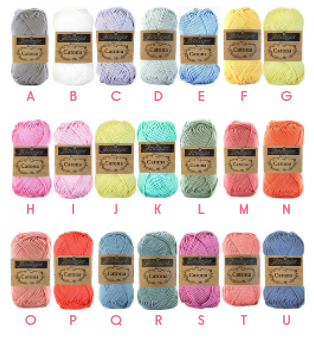
Rainbow version
Scheepjes Catona (100% mercerised cotton)- Colour A: 105 Bridal White x 8 (50g) ball
- Colour B: 385 Chrystalline x 1 (50g) ball
- Colour C: 253 Tropic x 1 (25g) ball
- Colour D: 397 Cyan x 1 (50g) ball
- Colour E: 146 Vivid Blue x 1 (50g) ball
- Colour F: 384 Powder Blue x 1 (25g) ball
- Colour G: 201 Electric Blue x 1 (25g) ball
- Colour H: 520 Lavender x 1 (50g) ball
- Colour I: 113 Delphinium x 1 (50g) ball
- Colour J: 251 Garden Rose x 1 (25g) ball
- Colour K: 128 Tyrian Purple x 1 (50g) ball
- Colour L: 519 Fresia x 1 (50g) ball
- Colour M: 114 Shocking Pink x 1 (50g) ball
- Colour N: 222 Tulip x 1 (25g) ball
- Colour O: 246 Icy Pink x 1 (25g) ball
- Colour P: 256 Cornelia Rose x 1 (50g) ball
- Colour Q: 115 Hot Red x 1 (25g) ball
- Colour R: 386 Peach x 1 (25g) ball
- Colour S: 281 Tangerine x 1 (25g) ball
- Colour T: 208 Yellow Gold x 1 (25g) ball
- Colour U: 280 Lemon x 1 (25g) ball
- Colour V: 392 Lime Juice x 1 (50g) ball
- Colour W: 205 Kiwi x 1 (25g) ball
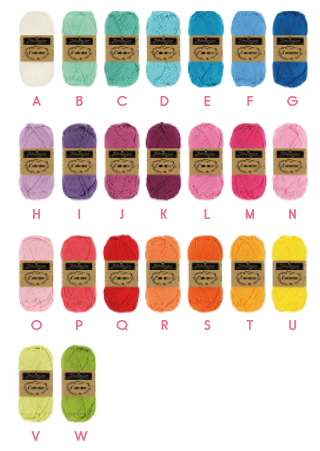
Shop the yarn!
You can find Scheepjes Catona via your local Scheepjes retailer or order online in these webshops:
Crochet hook
3.5mm (US size E/4).
Measurements
The blanket measures 120 x 87cm (47 x 34in) after blocking.
Gauge/tension
Gauge is not very critical for this pattern. It’s cumbersome to match gauge for all the different stitch patterns. If you want to make sure your blanket measurements are similar to the sample blanket, match this gauge: 17 hdc and 16 rows measure 10 x 10cm (4 x 4in) with a 3.5mm hook. Check your gauge by working a gauge square:
With Colour A, ch26.
Row 1 (RS) Starting in the second chain from hook, work 25hdc, ch1, turn. [25 hdc]
Rows 2-17 25hdc, ch1, turn.
Row 18 25hdc, cut yarn. Then measure of your gauge is the same as described above.
Notes
- This pattern is adapted from the full-sized Rainbow Sampler Blanket. As such, the different parts as described in that pattern have been kept as is, for easy reference.
- In most rows you’ll make a ch1 before turning your blanket. This is a turning chain and does not count as a stitch.
- Stitch multiples are given in the tutorials, simply ignore them if you’re following the instructions in this pattern.
- The instructions for the Rainbow version of this blanket are the same as for the Pastel version, but you do use different colours. The colour that you use for the Rainbow version is indicated between brackets in blue, in case it differs from the colour in the Pastel version.
- Want to swap yarns to Colour Crafter? Check out the Catona-to-Colour Crafter conversion table.
Abbreviations (US terms)
- ch: chain
- dc: double crochet
- hdc: half double crochet
- RS: Right Side
- WS: Wrong Side
Repeat formats
- *….; rep from * once/twice/3x Crochet the instructions after * and then repeat that section a further number of times as indicated.
- (…) once/twice/3x Crochet the instructions between brackets the total number of times indicated.
- […] Indicates the amount of stitches at the end of a row or round.
- (…) in same st/sp Indicates that all instructions between brackets are worked in the same stitch or space.
Colour layout
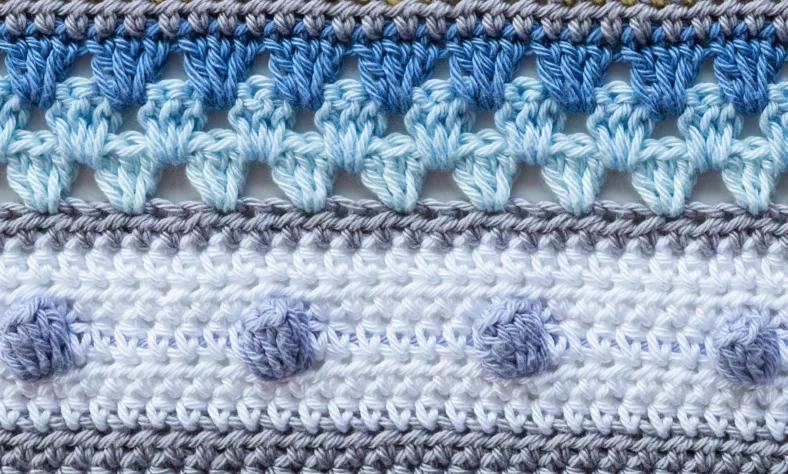
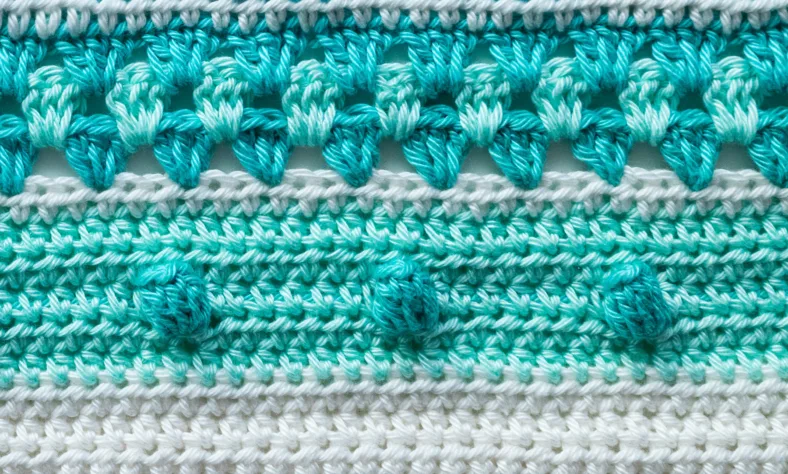

Techniques
Colour change
If you find ‘change colour’ in the instructions, change like this: Crochet the stitch before the colour change until you’ve reached the final yarn over that would finish the stitch. In the case of a hdc, you will now have three loops on your hook. Let the thread of the old colour hang on the backside, and grab the thread of the new colour with your hook (photo 1). Pull the loop of the new colour through your stitch to finish. You have now completed your stitch in the old colour, and you have a loop of the new colour on our hook (photo 2). You can now work your next stitch as instructed.
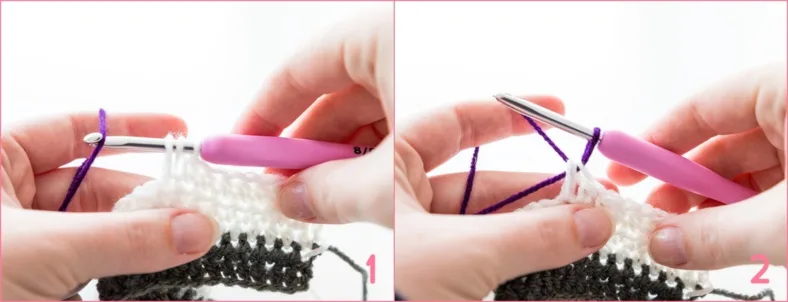
Popcorn with colour change
Click for the tutorial about the Popcorn stitch.
Granny Clusters
Click for the tutorial for Granny Clusters.
Crochet pattern
Starting rows (rows 1-3)
We’re going to start off easy with a few rounds to get the base of the blanket established.
With Colour A, ch146, turn.
Don’t worry if your starting chain isn’t as long as you would expect. Starting chains stretch a lot, and it will be stretched out by the volume of the stitches that you will crochet in the next rows. If you feel it’s very tight, use a slightly larger hook to make your chains and switch back to your normal hooksize afterwards.
Row 1 (WS) Starting in second ch from hook, 145hdc, ch1, turn. [145 hdc]
Row 2 (RS) 145hdc, ch1, turn. [145 hdc]
Row 3 (WS) 145hdc, cut yarn, turn. [145 hdc]
Popcorn section 1 (rows 4-9)
From now on we’ll be trying out all sorts of new stitches so you can add them to your crochet stitch repertoire. Are you ready for your first new stitch? We’re going to make popcorn stitches. Popcorns are stitches that are very visible in your work. They lay on top of your crochet, so they’re not very subtle. Especially not when you crochet them in a contrasting colour, such as in this section.
Please note: if you can’t get the colour change right, there’s no shame in crocheting the popcorns in the same colour as the background. I want you to have fun while exploring different stitches, and not be frustrated with the process.
Row 4 (RS) Join Colour B with a ss in first stitch, ch1, 1hdc in same stitch, 144hdc, ch1, turn. [145 hdc]
Row 5 (WS) 145hdc, ch1, turn. [145 hdc]
In the next row, you will crochet hdc’s with Colour B over the purple strand of Colour C and change colour when you crochet a popcorn. It’s to be expected that you see the strand of Colour C through the stitches of Colour B. It’s a darker colour trapped in white stitches, you can’t hide this completely, no matter how hard you try. It will not stand out in the blanket itself, the popcorns are much more interesting!
For detailed instructions on colour changing, see the Techniques section.
Row 6 (RS) 8hdc in Colour B, change to Colour C, *1 popcorn in Colour C, change to Colour B, 7hdc, change to Colour C; repeat from * another 15 times, 1 popcorn with Colour C, change to Colour B and cut Colour C, 8hdc in Colour B, ch1, turn. [17 popcorns, 128 hdc]
Do not pull on the purple thread too tight, because otherwise, you’ll lose stretch in the blanket that other rows do have. This means that your row is smaller and you’ll see this when your blanket is finished.
Row 7 (WS) 145hdc, ch1, turn. [145 hdc]
Row 8 (RS) 145hdc, cut yarn, turn. [145 hdc]
Row 9 (WS) Join Colour A with a ss in first stitch, ch1, 1hdc in same st, 144hdc, cut yarn, turn. [145 hdc]
Granny Cluster Section 1 (rows 10-13)
When you learn how to crochet, Granny squares are probably one of the first patterns you try. These are squares consisting of clusters of 3 double crochets that we call Granny clusters, and worked in the round. However, the pattern is easy to adapt to a row-based pattern. It’s a lovely rhythmical pattern. You will find this stitch on a couple of occasions in this blanket.
Don't forget: Blue colour codes are for the Rainbow version!
Row 10 (RS) Join Colour D (C) with a ss in first stitch, ch3 (counts as first dc), 1dc in same stitch, *skip 2 stitches, 3dc in next stitch; repeat from * another 46 times, skip 2 stitches, 2dc in last stitch, cut yarn, turn. [47 Granny clusters with 3 dc, 2 clusters with 2 dc, 145 dc in total]
We’ll be working the granny clusters back and forth because the front of the stitch doesn’t differ much from the back. This means that your next row will be worked on the wrong side.
Row 11 (WS) Join Colour E (B) with a ss in first stitch, ch3 (counts as first dc), *3dc in first space between clusters of previous row; repeat from * another 47 times, 1dc in third ch of begin-ch3 of previous row. Cut yarn, turn. [48 Granny clusters with 3 dc, 2 dc, 146 dc in total]
You might have noticed that we have 146 stitches in this row. We’ll fix that shortly.
Row 12 (RS) Join Colour U (C) with a ss in first stitch, ch3 (counts as first dc), 1dc in first space between clusters, *3dc in next space between clusters; repeat from * another 46 times, 1dc in final space, 1dc in third ch of begin-ch3 of previous row. Cut yarn, turn. [47 Granny clusters with 3 dc, 2 clusters with 2 dc, 145 dc in total]
Row 13 (WS) Join Colour A with a ss in first stitch, ch1, 1hdc in same stitch, 144hdc, cut yarn, turn. [145 hdc]
You’ll find that some stitches stretch more than others, causing your blanket to be a little bit wider than it was after the previous section. Don’t be alarmed, this will even out later with the border and blocking. As long as the blanket looks and feels good, you don’t have to worry.
Click here to continue to part 2.
Diagram
Key Part 1
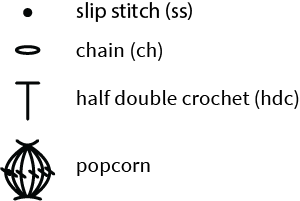
Crochet diagram part 1
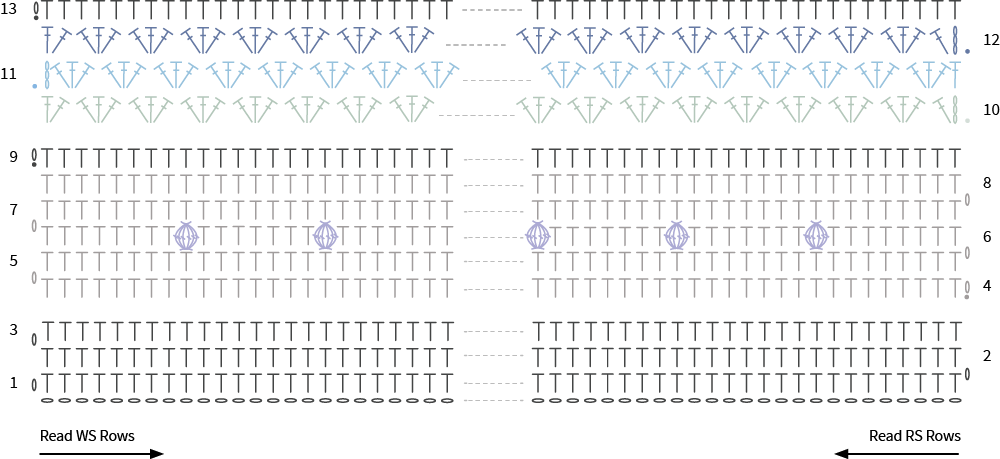



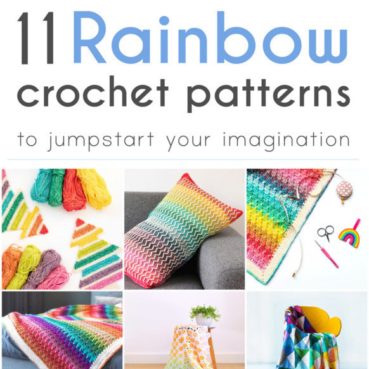
Comments